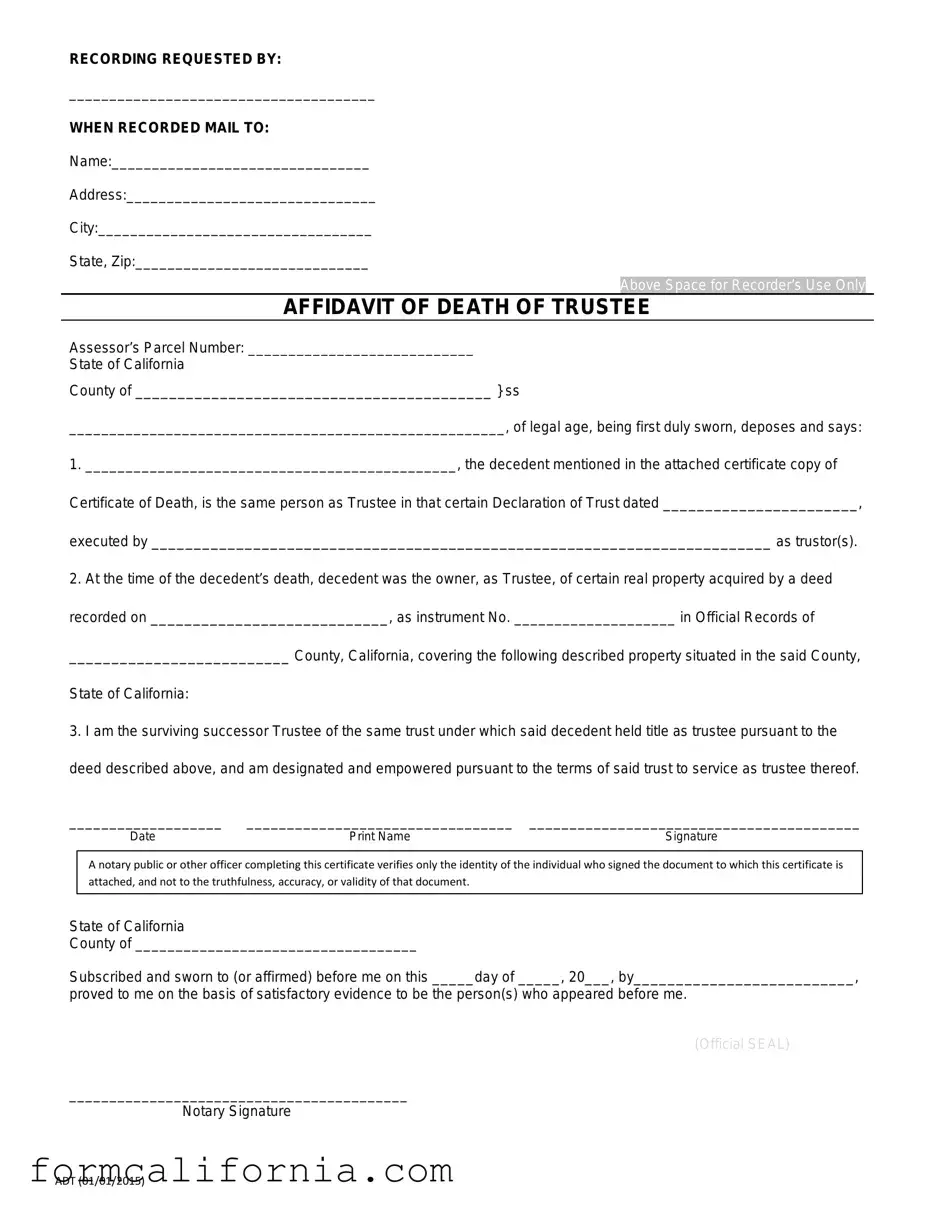The California Affidavit of Death of a Trustee form shares similarities with the Affidavit of Death of Joint Tenant form, in that both documents serve to legally notify relevant parties about the death of an individual who holds a certain title or ownership interest. Although the titles differ, the primary function remains the same: recording and formally acknowledging the death to facilitate the transfer of ownership or to clear title, specifically in real estate contexts.
In resemblance to the California Affidavit of Death of a Trustee, the Affidavit of Successor Trustee is another document used to assert a change in the person or entity that holds the responsibility to manage a trust after the original trustee has passed away. While the former confirms the death of a trustee, the latter primarily focuses on identifying and establishing the authority of the new trustee under the terms of the trust itself.
The California Transfer on Death (TOD) Deed form holds a conceptual similarity in that it also deals with the aftermath of an individual's death, specifically transferring real property ownership upon death directly to a named beneficiary, without the need for probate. However, unlike the Affidavit of Death of a Trustee, the TOD Deed is prepared and recorded in advance of death, demonstrating a proactive approach to estate planning.
Equivalent in purpose to facilitating the conveyance of information upon someone's death, the Affidavit of Heirship is used broadly across different states, including California, to establish ownership succession by identifying the rightful heirs to assets when someone dies intestate (without a will). This document, while broadly similar, specifically focuses on the inheritance process in the absence of a will or trust.
The Executor’s Deed is similar to the Affidavit of Death of a Trustee in which it's instrumental in the process of transferring property titles following an owner's death. The key distinction is that the Executor’s Deed is utilized within the context of probate, executed by the executor of an estate to transfer property as dictated by the will, underlining a distinct legal procedure compared to that of a trust administration.
The Last Will and Testament, although fundamentally a preparatory document rather than one confirming an event like the death of a trustee, bears similarity in its eventual role in the succession of assets and responsibilities. Upon the testator's death, the will becomes a pivotal document, directing the distribution of assets and appointment of guardians, executors, or trustees, thus intimately tying the individual's demise to legal and personal outcomes.
Similarly, the Declaration of Trust is pertinent as it establishes the terms and structure of a trust, appointing the initial trustee whose eventual death would necessitate the use of the Affidavit of Death of a Trustee. This foundational document outlines the duties, powers, and beneficiaries of the trust, making it a precursor to any changes in trusteeship due to death.
The Power of Attorney Termination form also intersects with the thematic process of dealing with changes due to someone's death, specifically by officially ending the powers granted in a Power of Attorney document because of the grantor's demise. Both documents signify a cessation of roles due to death, albeit in different contexts and with distinct legal ramifications.
Corresponding in their role in the real estate domain, the Grant Deed is utilized to transfer ownership of property from one party to another and requires information about the grantor (seller). Although not directly dealing with death, the seamless transition of property titles, as is necessary upon the passing of the trustee in the Affidavit of Death of a Trustee, highlights the importance of such documents in confirming transitions affected by death.
Lastly, the Living Trust document, similar to the Declaration of Trust, outlines the management and disposition of one’s assets but is operational during the grantor's lifetime and after death. The death of a trustee, as acknowledged by the Affidavit of Death of a Trustee, can cause the activation of successor trustees or clauses within the Living Trust, underscoring the interplay between life, death, and the ongoing management of assets.

